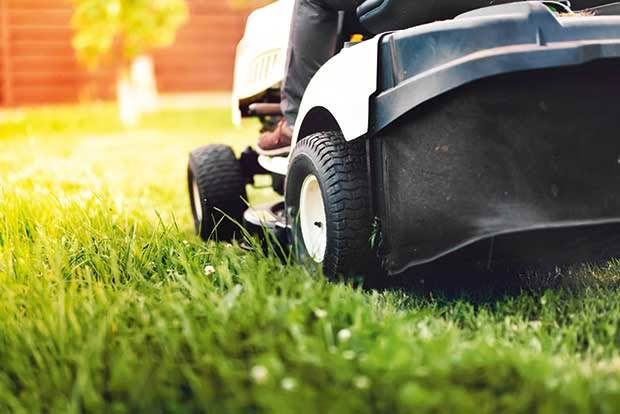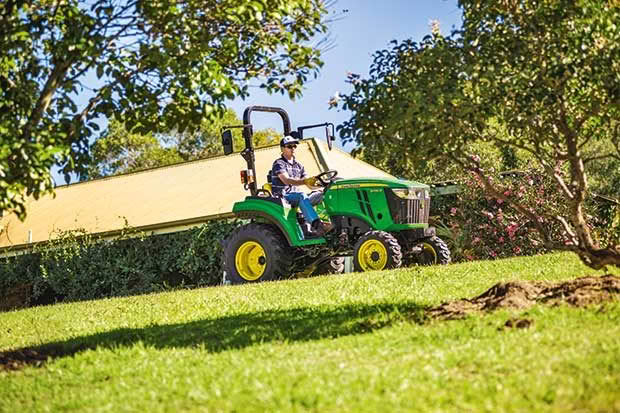6 mistakes to avoid when buying a ride-on lawn mower

Buying a ride-on mower is a big investment, and it can be difficult if you’re new to a block. Here are six mistakes you want to avoid.
Words: Nadene Hall
1. Don’t get a ride-on that’s too small (or too big) for your garden.
Ride-on mowers vary greatly in size. There are small, light models with 60cm-wide decks, designed to mow flat, fine-grass lawns.
At the large end, you’ll find heavy machines with 160cm-wide decks for large gardens which
can mow a lawn significantly faster.
The ride-on you need is the one that will fit through the gate into your garden.
2. The cheapest probably isn’t the most economical.
If your lawn is small and level, you will find a small, light ride-on mower is adequate.
But a larger, wider mower is going to do the job much faster.
If you often leave grass to grow long, a smaller machine is going to struggle. It will often be at the limit of its capabilities, causing belts and bearings to wear faster.
You need to use a machine well within its capabilities so it’s working efficiently, and that’s often a higher-spec, more expensive model.
3. Don’t buy a mower that’s too weak.
Every ride-on mower will have a brochure full of numbers. Horsepower and total displacement are the two that confuse some people.
Get the numbers wrong and you’ll either buy a machine that’s too weak to handle your requirements, or end up with one that is more than you need to do the job.

Horsepower (hp) is what makes the machine move forward and accelerate under normal conditions. If you have hills,
or you want to tow a trailer full of heavy stones, you need more horsepower.
Engine displacement gives you an indication of an engine’s power. It’s measured in cubic centimetres (cc or cm³); the higher the cc rating, the more powerful the engine and the more torque it generates.
Torque is the ‘grunt’ that turns the blades, and keeps them turning them under stress, like long, wet grass.
If your lawn is flat, your speed consistent and you mow regularly, you don’t need to pay for as much horsepower or torque as someone whose lawn is steep or is mowing rougher or longer lawns.
Ride-on mower engines vary in size, mostly from 13-37hp. The average is around 18hp and that will be perfectly adequate for most people.
A machine that is over-specification for your needs does have advantages. It will do the job faster, handle tough situations better, and last longer due to less stress on its components. However, it will be a bigger, heavier machine, and cost you more.
An underpowered machine, always working at its limits, won’t last as long. It will also be low in torque. If you put it under too much pressure, for example by trying to mow long, wet grass, the blades won’t turn as fast and you’ll get a poor finish.
It’s more likely to get blockages of grass under the deck as it can’t clear it out fast enough.
Worse, the mowing deck and engine come under a lot more pressure. There is a higher likelihood of breakages, and the machine will wear out more quickly.
4. Don’t buy a mower that can’t handle your terrain.
If your lawn is flat, you can buy almost any ride-on mower and it will do the job.
But many block owners want to mow grass on slopes. This requires a machine with a low centre of gravity. If it gets too steep, it’s going to require specialist machinery, or it may be too dangerous to mow it at all.

If there are slopes or steeper areas you want to mow, ask for an on-site demonstration from a dealer. A good salesperson will advise you on whether the machine can do the job safely.
Talk to a salesperson and explain the different types of mowing you want to do. If that’s not possible, ensure they have a good understanding of the slope angles on your property.
5. Don’t buy a mower if you have nowhere to store it.
Ride-on mowers are robust-looking machines, but they are not designed to withstand the weather. Rain, dust, humidity and hot temperatures will cause damage to belts, steel, joints and electrics.
The damage may be slow and hard to spot, but it will cost you extra in maintenance costs. Eventually, it will cause a major failure.
6 Don’t buy a ride-on unless you test it first.
If you have a lawn that is big enough for you to need a ride-on, it’s important
to be comfortable while you’re doing it.
Ride-on mowers come in a range of different shapes and sizes. You need to find one that is easy for you to mount and dismount, that is comfortable for your body shape and frame.
Controls need to be within easy reach. Can you easily empty a catcher? Tilt a deck? Turn to see behind you?
DON’T BE SCARED OF A RIDE-ON WITH NO STEERING WHEEL
Zero-turn mowers use levers to control speed and direction. You can mow straight lines at speed, then turn on the spot and set off again with no loss of time. It’s also easy to get around trees and garden beds.
However, the lever system can look quite alien to people who are used to driving a car.
If you can manage a supermarket trolley, you can operate a zero-turn ride-on mower. If you want to go forward, you push both handles forward; to reverse, you pull them back. To go right, you push the left lever forward, and to turn left, you push the right. To stop, you return the handles to neutral.
Love this story? Subscribe now!
 This article first appeared in NZ Lifestyle Block Magazine.
This article first appeared in NZ Lifestyle Block Magazine.
